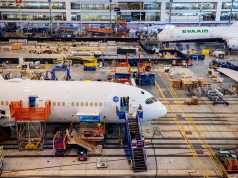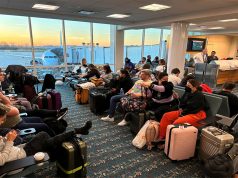
WASHINGTON/ZHUHAI — The U.S. Federal Aviation Administration issued an emergency airworthiness directive on Wednesday to address how to handle erroneous data from a sensor on the new Boeing 737 MAX jet in the wake of last week’s Indonesian jetliner crash.
Boeing Co said in a statement that it had alerted pilots to the issue. The FAA said it was mandating that airlines follow the Boeing bulletin.
The U.S. plane maker said investigators probing the Lion Air crash off the coast of Indonesia, in which all 189 on board were killed, had found that one of the “angle of attack” sensors on the Boeing 737 MAX jet had provided erroneous data.
Experts have said the angle of attack is a crucial parameter that helps the aircraft’s computers understand whether its nose is too high relative to the current of air – a phenomenon that can throw the plane into an aerodynamic stall and make it fall.
The FAA said the “erroneous inputs can potentially make the horizontal stabilizers repeatedly pitch the nose of the airplane downward, making the aircraft difficult to control.”
The agency said the order was effective immediately and applies to nearly 250 aircraft worldwide, including 45 in the United States operated by carriers including Southwest Airlines Co, United Airlines, and American Airlines Group Inc.
The FAA directive ordered operators to revise the airplane flight manual to give flight crews horizontal stabilizer trim procedures to follow under certain conditions.
Some modern aircraft have systems designed to correct the posture of the aircraft automatically to keep flying safely.
There are also procedures for pilots to follow in the event of missing data from damaged sensors on the fuselage, but it remained unclear how much time the crew of flight JT610 had to respond at the relatively low altitude of around 5,000 feet.
An angle of attack sensor had been changed by mechanics on the ground in Bali the day before the crash, Indonesia’s National Transportation Safety Committee (KNKT) has said.
The captain and first officer flying from Bali to Jakarta the night before the crash had indicators displaying differences in angle of 20 degrees, KNKT said, but that flight landed safely despite the issues in the air.
Boeing said in a statement received at China’s largest air show in Zhuhai that its bulletin to airlines underscored “existing flight crew procedures” designed to address circumstances where information coming into the cockpit from the sensors was wrong.
The Boeing 737 MAX has three such blade-shaped sensors. Erroneous readings can in some circumstances cause the 737 MAX to point the nose down sharply to keep air under the wings and avoid a stall, according to a person briefed on the matter.
Boeing’s bulletin related only to the 737 MAX, the latest version of the world’s most-sold family of aircraft, which has been in service for just over a year.
Boeing has delivered 219 737 MAX jets to customers globally, with 4,564 orders for jets yet to be delivered.
The Boeing 737 MAX is a more fuel-efficient version of the manufacturer’s best-selling single-aisle 737 series.
The Lion Air crash was the first involving the new version, which airlines introduced into service last year.
Indonesian authorities have downloaded information from the flight data recorder that showed a cockpit indicator on the Lion Air jet was damaged for its last four flights.
Authorities were still searching for the cockpit voice recorder, the second so-called “black box.”
KNKT said it would attempt to reconstruct the jet’s last flight using Boeing simulators in Seattle. The angle of attack sensor replaced in Bali would be analyzed at its place of manufacture in Chicago, the accident investigator said. —Reporting by Tim Hepher and David Shepardson Additional reporting by Cindy Silviana in Jakarta, Jamie Freed in Singapore and Allison Lampert in Montreal Editing by Himani Sarkar, Alexandra Hudson, Toni Reinhold







